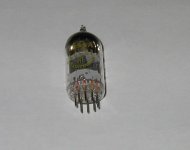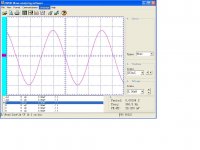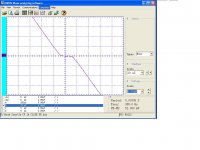Oh, my apologies Jan - I was sure I read somewhere that it was RF susceptibility. I must dig out Walt's writings to double check. Wasn't the replacement a JFET input type?
Well you see the article series was 4 parts: part 1, 2 by Walt, then an implementation and measurement part by yours truly, and there was a 4th part by Gary Galo applying the super regs in a piece of equipment. This was 1994.
In my part I described results with several opamps, the '825 mentioned by P-A was quite good IIRC. I think we only tried AD types, Walt working for AD at the time
jan didden
I must dig out Walt's writings to double check.
OK, here's the link to the paper I was recalling (fairly accurately as it turns out):
http://waltjung.org/PDFs/Improved_PN_Regs.pdf
and here's the relevant part:
Very high levels of RF noise were present (note that 'high' here only need be a few mV...)...This level of high frequency noise is sufficient to push a low noise bipolar front end device into a nonlinear input operating range... Although the AD797 didn't oscillate outright in this setup it simply wasn't as linear an error amplifier as might be desired.
(Page 14 Audio Electronics April 2000)
So as far as Walt was concerned, it was RF. I take back my apology
How do you know this has nothing to do with good sounding opamps incidentally?
Last edited:
I resent being compared to JR. That kind of abuse is totally uncalled for.
Holy mackeral, that was funny...now there's the humor I remember...
Luckily, I hadn't sipped my coffee before reading that.
Cheers, John
Actually, the AD825 has several real advantages for both line amp and regulator service. Two of these are: High open loop bandwidth, and high RF input tolerance.
The fact that the AD825 has little or no FM distortion is an added bonus, as this tends to make it sound better than most any other IC in this service. The biggest drawback is the high input noise. This keeps it from being used for phono front ends.
The fact that the AD825 has little or no FM distortion is an added bonus, as this tends to make it sound better than most any other IC in this service. The biggest drawback is the high input noise. This keeps it from being used for phono front ends.
Indeed. But it is a bit difficult, in case there is no decay, reverberation, ringing etc. after single-impulse or burst excitation of the circuit. It should have been, if Ed was correct, right?
Good point, but based on electrical behavior. Only if the acoustic impulse is strong enough to get past the buckling behavior (or similar) point will you see some resonances.
I suspect there is more lost than just translation. I suspect it is not clear when I am using the term resonances it means the acoustic or mechanical coupling very very close to electrical resonance. I think that issue has mislead some of the others.
I have never tried a whistle or organ pipe with a unit impulse to see if it begins to sound. The whistle might, a large organ pipe probably not.
Sorry John, I missed you reply:
No not THIS YEAR. But many of the previous years. I didn't go this year because the changes from year to year just aren't that great.
Why rant and rave? Have you seen me dis the high end? Can you provide a quote? I'll eat crow if you can provide one. I hear a lot that I like at the shows. What I like may not be the most popular choices, but there is still a lot to like. Some of it crazy expensive, some not. Some very, very good, some not.
Do I find it overpriced? Yes. But that's because I know the BOM of most of that stuff and also because I'm cheap. 1000% or more mark up is pretty steep. We are into pharmaceutical territory there.
But I do think there is some very good work being done. That opinion seems not to be shared by many on this forum. I actually like a lot of the high end stuff, but would rather build it myself.
I actually like a lot of the high end stuff, but would rather build it myself.
Were you there THIS YEAR? Because what we are talking about NOW is AUDIO TODAY.
No not THIS YEAR. But many of the previous years. I didn't go this year because the changes from year to year just aren't that great.
Why rant and rave? Have you seen me dis the high end? Can you provide a quote? I'll eat crow if you can provide one. I hear a lot that I like at the shows. What I like may not be the most popular choices, but there is still a lot to like. Some of it crazy expensive, some not. Some very, very good, some not.
Do I find it overpriced? Yes. But that's because I know the BOM of most of that stuff and also because I'm cheap. 1000% or more mark up is pretty steep. We are into pharmaceutical territory there.
But I do think there is some very good work being done. That opinion seems not to be shared by many on this forum.
OK, here's the link to the paper I was recalling (fairly accurately as it turns out):
http://waltjung.org/PDFs/Improved_PN_Regs.pdf
and here's the relevant part:
Very high levels of RF noise were present (note that 'high' here only need be a few mV...)...This level of high frequency noise is sufficient to push a low noise bipolar front end device into a nonlinear input operating range... Although the AD797 didn't oscillate outright in this setup it simply wasn't as linear an error amplifier as might be desired.
(Page 14 Audio Electronics April 2000)
So as far as Walt was concerned, it was RF. I take back my apology
How do you know this has nothing to do with good sounding opamps incidentally?
OK, yes, that's an other article, 5 years later in AE. I was referring to the 4-part series I participated in, I'm not familiar with this later article. You're excused
jan didden
Good point, but based on electrical behavior. Only if the acoustic impulse is strong enough to get past the buckling behavior (or similar) point will you see some resonances.
I suspect there is more lost than just translation. I suspect it is not clear when I am using the term resonances it means the acoustic or mechanical coupling very very close to electrical resonance. I think that issue has mislead some of the others.
I have never tried a whistle or organ pipe with a unit impulse to see if it begins to sound. The whistle might, a large organ pipe probably not.
buckling point? I can show you a load cell (2" thick steel beam) that is "bent" by a single penny. You just need a sensitive enough microphone to see the ringing of an organ pipe from an acoustical impulse.
"when I am using the term resonances it means the acoustic or mechanical coupling very very close to electrical resonance."
buckling point? I can show you a load cell (2" thick steel beam) that is "bent" by a single penny. You just need a sensitive enough microphone to see the ringing of an organ pipe from an acoustical impulse.
"when I am using the term resonances it means the acoustic or mechanical coupling very very close to electrical resonance."I would think most electrical resonances in amplifiers are far beyond 20kHz
Scott,
I am amazed by how we use the same words and get different meanings.
Buckling is not linear behavior, deflection in your example is linear.
As most organists will be glad to tell you it takes time for an organ pipe to sound after it is keyed. Resonances in acoustic form take energy to build and then decay after the excitation is removed. In the case of a real organ there is also a delay due to distance. But if you think about exciting even a 20 foot pipe it takes the pressure modulation 18ms just to reach the end of the pipe!
If you are sweeping a vacuum tube amplifier are you waiting long enough to see the resonance?
One of the really silly topics in IEEE Spectrum many years ago was after the report on a digital organ synthesizer one of the letters to the editor mentioned the frequency accuracy of the finished product. The reply stated it was perfect as it was crystal controlled. A true lack of knowledge! Pipes can start around their final frequency before reaching it. Pipes can be tuned by ear to what is perceived as perfect pitch not exactly the octave perfect math gives you. Of course pipes can also couple to each other.
That is why I mean acoustic resonances and electrical are not the same. It has little to do with frequency.
Pavel,
Just how much resolution do you have on your unit impulse measurements? I suspect you average response to get cleaner results. That is one way to use the time dimension. The Cepstrum pretty much does the inverse.
I know most of your work is modern solid state and would expect very little to show up in such gear. But if you have a program that will show the time dimension, I encourage you to try it.
ES
Scott,
I am amazed by how we use the same words and get different meanings.
Buckling is not linear behavior, deflection in your example is linear.
Buckling as you used it implies (to me) an allusion to the mythical dead zone behavior.
"Only if the acoustic impulse is strong enough to get past the buckling behavior (or similar) point will you see some resonances."
My counter example was of linear behavior under extremely small strain. The organ pipe probably responds linearly to a fly walking on it, if you could measure it. I have experimented with Tibetan singing bowls and the resonances decay smoothly to well below the noise floor, seconds past inaudibility.
Last edited:
I know most of your work is modern solid state and would expect very little to show up in such gear. But if you have a program that will show the time dimension, I encourage you to try it.
ES
Definitely. I am working on this.
Attachments
Buckling as you used it implies (to me) an allusion to the mythical dead zone behavior.
"Only if the acoustic impulse is strong enough to get past the buckling behavior (or similar) point will you see some resonances."
My counter example was of linear behavior under extremely small strain. The organ pipe probably responds linearly to a fly walking on it, if you could measure it. I have experimented with Tibetan singing bowls and the resonances decay smoothly to well below the noise floor, seconds past inaudibility.
Scott,
We were discussing attack not decay. Decay as far as I have found is always clean and linear unless of course it drops down low enough to be in the dead zones you don't believe in. Attack of a resonance must be started, you are certainly allowed to believe whatever you want. I'll look at measurements, experience and results.
I did an interesting church sometime back where the truncated transcepts acted as a classic Helmholtz resonator. Every one else had tried magic speakers, coating all of the ceiling with a thin layer of sound absorbing plaster, covering the back wall etc. Speech intelligibility was terrible. Adding 16 sabins in the right spot to each side solved the problem! Measured by both STI, humans and other software. A very non-linear result.
Attached is a screen shot of a voltage divider using a "good" resistor for the bottom and a "not so good" for the top. Multiple averages and a low noise preamp were added.
ES
Attachments
Pano, could you justify your assertions that the BOM is 10:1, and higher in most audio hi end equipment?
What's the BOM for a large Bybee QP?
It is certainly NOT my experience, and 5:1 is the industry standard.
It's not a standard. It's just a rule of thumb that some choose to use.
It may be fairly common, but it's hardly standard.
se
Pano, could you justify your assertions that the BOM is 10:1, and higher in most audio hi end equipment?
On a public forum? No. That would get me in very hot water. But I do know several current examples. I don't think I implied that it's 10:1 in ALL high end gear. (If I did, it was not meant that way) In all fairness, some high end audio may have lower than average margins because otherwise the cost would be ridiculous.
The main point, of course, is that this is a DIY forum where we choose to Do It Ourselves. There is enough knowledge out there and an ample supply of affordable parts to build very good audio gear as a hobby. That's not true of a lot of other industries. Maybe in boat building or cooking.
- Status
- Not open for further replies.
- Home
- Member Areas
- The Lounge
- John Curl's Blowtorch preamplifier part II


